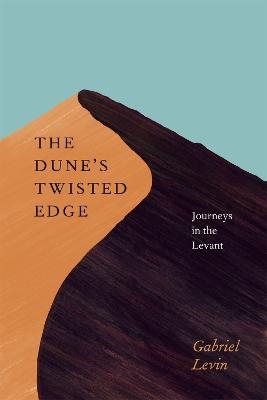
The Dune's Twisted Edge
Journeys in the Levant
Seiten
2012
University of Chicago Press (Verlag)
978-0-226-92367-3 (ISBN)
University of Chicago Press (Verlag)
978-0-226-92367-3 (ISBN)
Deals with the author's journeys in the Levant, the exotic land that stands at the crossroads of western Asia, the eastern Mediterranean, and northeast Africa. Part travelogue, part field guide, and part literary appreciation, this title assembles six interlinked essays that explore the seaboard of the Levant and its deserts.
Journeys in the Levant. "How to speak of the imaginative reach of a land habitually seen as a seedbed of faiths and heresies, confluences and ruptures...trouble spot and findspot, ruin and renewal, fault line and ragged clime, with a medley of people and languages once known with mingled affection and wariness as Levantine?" So begins poet Gabriel Levin in his journeys in the Levant, the exotic land that stands at the crossroads of western Asia, the eastern Mediterranean, and northeast Africa. Part travelogue, part field guide, and part literary appreciation, "The Dune's Twisted Edge" assembles six interlinked essays that explore the seaboard of the Levant and its deserts, bringing to life this enigmatic part of the world. Striking out from his home in Jerusalem in search of a poetics of the Fertile Crescent, Levin probes the real and imaginative terrain of the Levant, a place that beckoned to him as a source of wonder and self-renewal.
His footloose travels take him to the Jordan Valley; to Wadi Rumm south of Petra; to the semiarid Negev of modern-day Israel and its Bedouin villages; and, in his recounting of the origins of Arabic poetry, to the Empty Quarter of Arabia where the pre-Islamic poets once roamed. His meanderings lead to encounters with a host of literary presences: the wandering poet-prince Imru al-Qays, Byzantine empress Eudocia, British naturalist Henry Baker Tristram, Herman Melville making his way to the Dead Sea, and even New York avantgarde poet Frank O'Hara. When he is not confronting ghosts, Levin finds himself stumbling upon the traces of vanished civilizations. He discovers a ruined Umayyad palace on the outskirts of Jericho, the Greco-Roman hot springs near the Sea of Galilee, and Nabatean stick figures carved on stones in the sands of Jordan. Vividly evoking the landscape, cultures, and poetry of this ancient region, "The Dune's Twisted Edge" celebrates the contested ground of the Middle East as a place of compound myths and identities.
Journeys in the Levant. "How to speak of the imaginative reach of a land habitually seen as a seedbed of faiths and heresies, confluences and ruptures...trouble spot and findspot, ruin and renewal, fault line and ragged clime, with a medley of people and languages once known with mingled affection and wariness as Levantine?" So begins poet Gabriel Levin in his journeys in the Levant, the exotic land that stands at the crossroads of western Asia, the eastern Mediterranean, and northeast Africa. Part travelogue, part field guide, and part literary appreciation, "The Dune's Twisted Edge" assembles six interlinked essays that explore the seaboard of the Levant and its deserts, bringing to life this enigmatic part of the world. Striking out from his home in Jerusalem in search of a poetics of the Fertile Crescent, Levin probes the real and imaginative terrain of the Levant, a place that beckoned to him as a source of wonder and self-renewal.
His footloose travels take him to the Jordan Valley; to Wadi Rumm south of Petra; to the semiarid Negev of modern-day Israel and its Bedouin villages; and, in his recounting of the origins of Arabic poetry, to the Empty Quarter of Arabia where the pre-Islamic poets once roamed. His meanderings lead to encounters with a host of literary presences: the wandering poet-prince Imru al-Qays, Byzantine empress Eudocia, British naturalist Henry Baker Tristram, Herman Melville making his way to the Dead Sea, and even New York avantgarde poet Frank O'Hara. When he is not confronting ghosts, Levin finds himself stumbling upon the traces of vanished civilizations. He discovers a ruined Umayyad palace on the outskirts of Jericho, the Greco-Roman hot springs near the Sea of Galilee, and Nabatean stick figures carved on stones in the sands of Jordan. Vividly evoking the landscape, cultures, and poetry of this ancient region, "The Dune's Twisted Edge" celebrates the contested ground of the Middle East as a place of compound myths and identities.
Gabriel Levin is the author of four books of poems, most recently To These Dark Steps, and has published several collections in translation. He lives in Jerusalem.
| Erscheint lt. Verlag | 4.1.2013 |
|---|---|
| Sprache | englisch |
| Maße | 16 x 22 mm |
| Gewicht | 397 g |
| Themenwelt | Literatur ► Essays / Feuilleton |
| Reisen ► Reiseberichte ► Naher Osten | |
| Reisen ► Reiseberichte ► Asien | |
| Geisteswissenschaften ► Geschichte ► Regional- / Ländergeschichte | |
| Geisteswissenschaften ► Sprach- / Literaturwissenschaft ► Anglistik / Amerikanistik | |
| ISBN-10 | 0-226-92367-3 / 0226923673 |
| ISBN-13 | 978-0-226-92367-3 / 9780226923673 |
| Zustand | Neuware |
| Haben Sie eine Frage zum Produkt? |
Mehr entdecken
aus dem Bereich
aus dem Bereich
Buch | Hardcover (2012)
Westermann Schulbuchverlag
CHF 44,90
Schulbuch Klassen 7/8 (G9)
Buch | Hardcover (2015)
Klett (Verlag)
CHF 29,90
Buch | Softcover (2004)
Cornelsen Verlag
CHF 23,90


